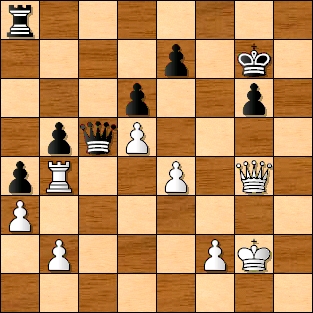Paul Charles Morphy – Adolf Anderssen
Match game 1; Paris, December 20, 1858
Evans Gambit C52
Morphy usually was a bad starter, and, furthermore, he was even ill for the first two games of his match against Anderssen. But quite strangely, he refused to postpone the match. A year later, Anderseen got a clearer idea of what it happened, as he wrote to Tassilo von Heydebrand und der Lasa in a private letter dated December 31, 1859: “Altogether, he is not only a great chess player but also a great diplomat and all maneuvers which he
inaugurated in reference to me since his arrival in England had not other purpose than to lure me to
Paris and to burden me with the inconvenience of the trip. Likewise, I admired from the very beginning
as a very tactful diplomatic maneuver that he took to his bed when I arrived in Paris, and I have never
changed my mind about that”.
1. e4 e5 2. Nf3 Nc6 3. Bc4 Bc5 4. b4!? Bxb4 5. c3 Ba5 6. d4 exd4 7. 0-0 Nf6? Morphy himself will write in his chess column for The New York Ledger of October 8, 1859: “The move recommended by Herr Anderssen at this stage of the Evans and played by him in his first match game with Mr. Morphy, is 7. ... Nf6. We have analyzed the move with great care, and have found that 8. Ba3 gave White a very fine attacking game”. 8. e5? Four months later Morphy was finally able to test his discovery: 8. Ba3! d6 9. e5! with an overwhelming initiative, P. C. Morphy – Greenaway, 8-board blindfold simultaneous exhibition, London 1859. 8. ... d5 9. Bb5 Ne4 10. cxd4. Géza Maróczy appears to regard 10. Qa4 0-0 11. Bxc6 Bxc3 12. Nxc3 Nxc3 13. Qc2 bxc6 14. Nxd4 c5 as more drawish. 10. ... 0-0! 11. Bxc6 bxc6 12. Qa4 Bb6 13. Qxc6 Bg4 14. Bb2. Wilhelm Steinitz called it a serious strategical error, both materially and immaterially. He gives as better 14. Be3, but then 14. ... f6 (Maróczy) was quite in Black’s favour anyway. 14. ... Bxf3 15. gxf3 Ng5 16. Nd2 Re8? As Johann Jacob Löwenthal pointed out, 16. ... Nh3+ followed by ... Qd8-h4 and then eventually ... Ra8-e8-e6 was almost crushing. Anderssen probably overlooked Morphy’s subtle 18th move. 17. Kh1 Nh3

18. f4! “Wonderful! By opening the third rank for his pieces and capitalizing on the chance to coordinate his forces, Morphy finds the only way to avoid an inglorious and unresisting end as would have happened after 18. Nb3 Re6 19. Qc2 Qh4 20. Bc1 Bxd4 21. Nxd4 Qxd4 22. Bb2 Qf4”, Grandmaster Valeri Beim writes in his book “Paul Morphy Una Prospettiva Moderna”, Roma, Prisma Editori, 2008, p. 171. 18. ... Qh4 19. Qxd5 Nxf2+ 20. Kg1 Nd3 21. Bc3 Nxf4. As Beim observes, 21. ... c5! might have been well stronger here. 22. Qf3. Beim recommends 22. Qe4!? Ng6 23. Qxh4 Nxh4 24. Nc4 as more tenable because “Black would not have a great advantage”, but such an admission could not appeal Morphy’s eager for eternity. 22. ... Nh3+ 23. Kh1 Ng5 24. Qg2 Rad8 25. Rg1! Maróczy wisely suggests 25. Nf3 Nxf3 26. Qxf3 Bxd4 27. Bxd4 Qxd4 28. Qxf7+ Kh8 29. Rae1 thinking and dreaming about saving a draw in the endgame a Pawn down. But no! Such a stuff is not worth Morphy’s looking at. 25. ... h6 26. Raf1 Qh3 27. Qc6? This is actually the losing move! As Beim demonstrated through long analysis, after 27. Qxh3 Nxh3 28. Rg4! followed by Nd2-e4 White should not lose, and, if Black plays badly, he could even win! 27. ... Qd7 28. Qg2
Bxd4 29. Bxd4 Qxd4 30. Nf3 Qd5 31. h4 Ne6 32. Qg4 Qc6 33. Rg2 Rd3
34. Qf5 Red8 35. Qf6. Fighting to the end. If, instead, 35. Qxf7+ Kxf7 36. Nd4+ then 35. ... Rf3! finis. 35. ... Qd5 36. Qf5 Rd1 37. Rxd1 Qxd1+ 38. Kh2 Rd3
39. Rf2 Re3. “True to his principles, Anderssen is prepared to part with some of his material advantage to increase the positional. Despite White’s desperate resistance, he unhurriedly brings his advantage home”. (Beim, op. cit., p. 173). 40. Nd2 Re2 41. Qxf7+ Kh8 42. Ne4 Rxf2+ 43. Nxf2 Qd5
44. Ng4 Qxa2+ 45. Kg3 Qb3+ 46. Kh2 Qc2+ 47. Kg3 Qc3+ 48. Kh2 Qc6
49. h5 a5 50. Nf6 gxf6 51. Qxf6+ Kg8 52. Qg6+ Kf8 53. Qxh6+ Ke8
54. Qg6+ Kd7 55. h6 Qd5 56. h7 Qxe5+ 57. Kg1 Ng5 58. h8=Q Qxh8
59. Qxg5 Qd4+ 60. Kf1 a4 61. Qf5+. “Or 61. Qb5+ Kd6 62. Qa6+ c6 and checks are over”, writes Grandmaster Enrico Paoli in his book “Il Finale negli Scacchi”, Milano, Mursia, 1974, p. 461. 61. ... Kc6 62. Qc8 Kb5! 63. Ke1. “Not 63. Qxc7 Qc4+. If 63. Qb7+ Qb6 64. Qd5+ c5 65. Qd7+ Qc6 66. Qd3+ c4”. (Paoli, ibidem). 63. ... c5 64. Qb7+ Kc4 65. Qf7+ Kc3 66. Qf3+ Qd3 67. Qf6+ Kb3 68. Qb6+ Kc2 69. Qa7. “Again the Pawn was taboo”. (Paoli, ibidem). 69. ... Qc3+ 70. Ke2 a3 71. Qa4+. “Or 71. Qh7+ Kb2 72. Qb7+ Ka2 73. Qf7+ c4 etc.”. (Paoli, ibidem). 71. ... Kb2 72. Qb5+ Qb3! 0 : 1.

Paul Charles Morphy (R.) vs. Adolf Anderssen (L.)
Image courtesy of
Chess Graphics
















































